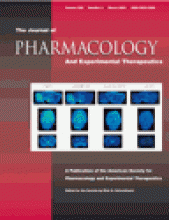Abstract
Brief activation of the ATP-sensitive P2X7 receptor (P2X7R) stimulates the maturation and release of interleukin 1β (IL-1β)in macrophages, whereas prolonged agonist activation induces the formation of cytolytic pores in cell membranes. The present study investigated potential downstream mechanisms associated with native human P2X7R activation in lipopolysaccharide and interferon-γ differentiated THP-1 cells. 2,3-O-(4-Benzoylbenzoyl)-ATP (BzATP)-induced pore formation (EC50 = 35 μM) was blocked by a selective P2X7R antagonist, 1[N,O-bis(5-isoquinolinesulfonyl)-N-methyl-l-tyrosyl]-4-phenylpiperazine (KN-62) (IC50 = 44 nM) and by pyridoxal phosphate-6-azophenyl-2-4-disulfonic acid (PPADS) (IC50 = 344 nM). KN-62 and PPADS also blocked BzATP-induced IL-1β release (EC50 = 617 μM) with IC50 values of 75 and 3500 nM, respectively. The selective p38 mitogen-activated protein kinase (MAPK) inhibitor, 4-(4-fluorophenyl)-2-(4-hydroxyphenyl)-5-(4-pyridyl)-1H-imidazole (SB 202190), potently inhibited BzATP-induced pore formation (IC50 = 75 nM) but did not alter P2X7-mediated calcium influx or IL-1β release. SB 202190 and KN-62 also attenuated BzATP-mediated activation of phosphorylated p38 MAPK (pp38 MAPK). Two caspase inhibitors, YVAD (caspase 1) and DEVD (caspase 3), attenuated both BzATP-induced pore formation and IL-1β release in a concentration-dependent fashion. Neither DEVD nor p38-MAPK inhibitors blocked cell membrane pore formation evoked by maitotoxin or by activation of human P2X2a receptors. These results indicate that P2X7R-mediated pore formation results from a coordinated cascade involving both the p38 MAPK and caspase pathways that is distinct from other cytolytic pore-forming mechanisms. In contrast, P2X7R-mediated IL-1β release is dependent on caspase activity but not p38 MAPK. Taken together, these results support the hypothesis that downstream cellular signaling mechanisms, rather than channel dilation, mediate cytolytic pore formation after prolonged agonist activation, which underlies P2X7 receptors.
Footnotes
-
DOI: 10.1124/jpet.103.059600.
-
ABBREVIATIONS: LPS, lipopolysaccharide; P2XR, purinergic receptor; BzATP, 2,3-O-(4-benzoylbenzoyl)-ATP; IL-1β, interleukin-1β; MTX, maitotoxin; PD 98059, 2′-amino-3′-methoxyflavone; SB 203580, 4-(4-fluorophenyl)-2-(4-methylsulfinylphenyl)-5-(4-pyridyl)1H-imidazole; PD 169316, 4-(4-fluorophenyl)-2-(4-nitrophenyl)-5-(4-pyridyl)1H-imidazole; JNK, c-Jun NH2-terminal kinase; IFNγ, interferon-γ; ELISA, enzyme-linked immunosorbent assay; MAPK, mitogen-activated protein kinase; pp38 MAPK, phosphorylated p38 MAPK; FLIPR, Fluorometric Imaging Plate Reader; DPBS, Dulbecco's phosphate-buffered saline; PKC, protein kinase C; MEK, mitogen-activated protein kinase kinase; ERK, extracellular signal-regulated kinase; PPADS, pyridoxal phosphate-6-azophenyl-2-4-disulfonic acid; KN-62, 1-[N,O-bis(5-isoquinolinesulfonyl)-N-methyl-l-tyrosyl]-4-phenylpiperazine; U0126, 1,4-diamino-2,3-dicyano-1,4-bis(methylthio)butadiene; U0124, 1,4-diamino-2,3-dicyano-1,4-bis(aminophenylthio)butadiene; SB 202190, 4-(4-fluorophenyl)-2-(4-hydroxyphenyl)-5-(4-pyridyl)-1H-imidazole; SB 202474, 4-(ethyl)-2-(4-methoxyphenyl)-5-(4-pyridyl)-1H-imidazole; Ro-31-7549, bisindolylmaleimide VIII acetate, 2-[1-3-(aminopropyl)indol-3-yl]-3-(1-methyl-1H-indol-3-yl) maleimide; Gö-6976, 12-(2-cyanoethyl)-6,7,12,13-tetrahydro-13-methyl-5-oxo-5H-indolo(2,3-α)pyrrolo(3,4-c)-carbazole; Ro-31-8220, bisindolylmaleimide IX, 3-[1-[3-(amidinothio)propyl-1H-indol-3-yl]-3-(1-methyl-1H-indol-3-yl) maleimide.
- Received September 4, 2003.
- Accepted November 10, 2003.
- The American Society for Pharmacology and Experimental Therapeutics
JPET articles become freely available 12 months after publication, and remain freely available for 5 years.Non-open access articles that fall outside this five year window are available only to institutional subscribers and current ASPET members, or through the article purchase feature at the bottom of the page.
|






